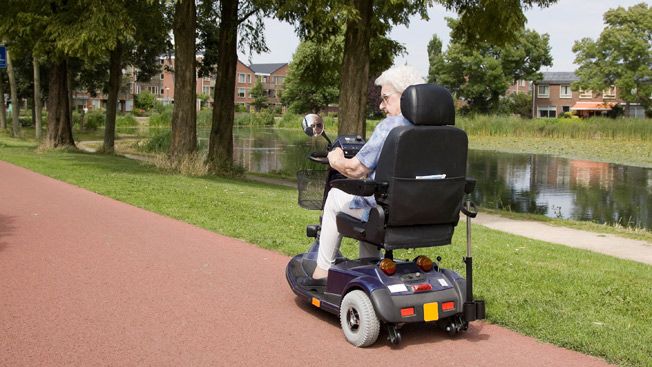Mobility scooters: a guide for the beginner

A mobility scooter is likely to be a one-time acquisition and one that we’ve never been involved with before, so it can be hard to know where to start. Here’s a quick guide to some of the areas to consider when you’re finding the right vehicle for your parent.
The decision to purchase a mobility scooter can be emotional for everyone involved.
Finding the right scooter can be particularly stressful, when the choice seems overwhelming. On top of this, some might feel that they’re accepting defeat when they decide to buy a scooter.
In fact, choosing to buy a mobility scooter does not mean that you’re giving up. It actually means that you’re not prepared to lose your independence without a fight – and the right tools for the job!
So, how do you find the right one amongst the many that are available?
Where will it be going?
Before you think about anything else, consider where the scooter will be used.
Is it for local short-distance trips for the shop, or a slightly longer journey? Does it need to go over rough terrain?
Does it need to fit into one or a variety of cars for any day trips or holidays?
There are two main categories that scooters fit into:
- Class 2 for pavement and pathway
- Class 3 for pavement and road
Class 2 mobility scooters
Class 2 scooters have a top speed of 4mph. These can’t be used on the road and are for pavements and pathways only.
Often, scooters in this category are lightweight. It may be possible to fold the scooter so that it fits into a car.
Don’t worry if your parent lives in a rural area where pavements aren’t always available. If there is absolutely no alternative then a Class 2 scooter will be allowed on the road. Try to plan routes that don’t require this, for your parent’s own safety and consideration of other road users.
Class 3 mobility scooters
This category often includes the most heavy duty mobility scooters.
Class 3 scooters can be used at 4mph on the pavement, but can also be used at speeds of up to 8mph on the road.
The owner needs to register a Class 3 scooter but will not need to pay tax.
There are no legal requirements to insure the vehicle, though it is wise to protect such a valuable piece of equipment. Specialist insurers offer mobility scooter insurance for as little as £30 per year.
Class 3 scooters aren’t generally as portable, but they’re usually more capable of handling a range of terrains. If your parent expects to travel over longer distances, they might be the more suitable choice.
Mobility scooters can’t be used on motorways, in cycle lanes or along bus lanes. You’ll need to fix a flashing amber light to the vehicle, to warn other road users of its presence. Drivers are not allowed to park on the pavement, blocking pedestrian access.
What are the costs associated with mobility scooters?
Mobility scooters can cost as much to buy as a small car. The larger and faster scooters are the more expensive ones, whilst small and lightweight scooters are significantly cheaper.
As well as the initial outlay bear in mind the additional costs that will need to find their place in the budget.
Scooters will need to be serviced every 12 to 18 months, and many manufacturer warranties will only continue to run if the scooter is serviced annually.
Mobility scooter servicing will cost around £70 to £150, depending on where you go and what’s included in the price. Parts may cost extra, though small repairs are often included.
Where will the scooter be stored?
Before buying, think about scooter storage. Compact mobility scooters might find their place inside the house, or could be stored in a car or van – though bear in mind the security risks involved.
Larger scooters won’t fold down or fit neatly by the wall in the hallway. They will probably need a secure shed, or garage for storage.
Finally…
Try before you buy! Your parent’s comfort is important, and not all scooters will suit them. Visit a shop to take scooters for a test drive, where you’ll discover which ones meet your parent’s needs.
After you’ve chosen a scooter, you can buy directly or might be able to save money by buying your mobility scooter online. You could also think about reducing the cost by purchasing a pre-owned vehicle.
Thanks to MobilitySmart for providing the tips in this article. Find out more about their range of new mobility scooters on their website.
This article was published in August 2016.
If you found this article useful you may also like to read:
- Improvements in accessibility in public transport
- Summer energy savings tips
- How to stay warm and save money in the winter

